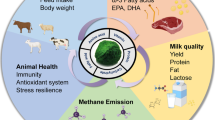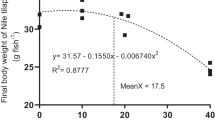Abstract
Macrocystis pyrifera (Linnaeus) C. Agardh, known in some regions as ‘giant kelp’, occurs along temperate coastal rocky reefs throughout the southern hemisphere, as well as along the north-east Pacific coastline. In Chile, it serves as a major source of abalone feed within the abalone industry, with considerable literature on cultivation of the species. Here we attempt to cultivate South African M. pyrifera through vegetative propagation and investigate its use as a feed for the abalone, Haliotis midae. Kelp holdfasts were attached to a rope-raft system in Saldanha Bay, South Africa, and monitored over 3 months. In addition, a 6-month H. midae feed inclusion trial was carried out, which compared the use of M. pyrifera with the predominant commercial kelp feed species, Ecklonia maxima. Young M. pyrifera grew well on the culture system, with mean upright length nearly doubling over the culture period (55.6–102.2 cm) and displayed mean upright relative growth rates between 0.99 and 1.22% day-1. Additionally, holdfasts developed new uprights and holdfasts increased in size, growing around culture lines. Simulated partial harvesting of samples stopped upright elongation, but samples survived, whereas complete removal of uprights caused mortality. Haliotis midae fed with M. pyrifera + formulated feed (SAF 3000®) displayed comparable growth rates to the E. maxima + SAF 3000® diet. No significant differences in mean specific growth rate (M. pyrifera 0.19, E. maxima 0.18% body weight day-1), daily increment in shell length (M. pyrifera 31.19, E. maxima 24.64 μm day-1), condition factor (M. pyrifera 1.37, E. maxima 1.40 g mm-1) and mortality rate were identified between the two diets. Additionally, H. midae consumed significantly less M. pyrifera than E. maxima, suggesting potential differences in feed conversion ratio/kelp nutritional composition among the kelp species. These findings provide baseline information for the potential cultivation and use of M. pyrifera as a new source of fresh seaweed feed in the South African abalone industry.




Similar content being viewed by others
References
Anderson RJ, Levitt GJ, Share A (1996) Experimental investigations for the mariculture of Gracilaria in Saldanha bay, South Africa. J Appl Phycol 8:421–430
Anderson RJ, Rothman MD, Share A, Drummond H (2006) Harvesting of the kelp Ecklonia maxima in South Africa affects its three obligate, red algal epiphytes. J Appl Phycol 18:343–349
Barkai R, Griffiths CL (1986) Diet of the South African abalone Haliotis midae. S Afr J Marine Sci 4:37–44
Bolton JJ, Robertson-Andersson DV, Shuuluka D, Kandjengo L (2009) Growing Ulva (Chlorophyta) in integrated systems as a commercial crop for abalone feed in South Africa: a SWOT analysis. J Appl Phycol 21:575–583
Bolton JJ, Davies-Coleman MT, Coyne VE (2013) Innovative processes and products involving marine organisms in South Africa. Afr J Mar Sci 35:449–464
Britz PJ (1996) The suitability of selected protein sources for inclusion in formulated diets for the South African abalone, Haliotis midae. Aquaculture 140:63–73
Britz PJ, Hecht T (1997) Effect of dietary protein and energy level on growth and body composition of South African abalone, Haliotis midae. Aquaculture 156:195–210
Buschmann AH, Varela DA, Hernández-González MC, Huovinen P (2008) Opportunities and challenges for the development of an integrated seaweed-based aquaculture activity in Chile: determining the physiological capabilities of Macrocystis and Gracilaria as biofilters. J Appl Phycol 20:571–577
Buschmann AH, Prescott S, Potin P, Faugeron S, Vásquez JA, Camus C, Infante J, Hernández-González MC, Gutierrez A, Varela DA (2014) The status of kelp exploitation and marine agronomy, with emphasis on Macrocystis pyrifera in Chile. Adv Bot Res 71:161–188
Camus C, Buschmann AH (2017) Macrocystis pyrifera aquafarming: production optimization of rope-seeded juvenile sporophytes. Aquaculture 468:107–114
Camus C, Infante J, Buschmann AH (2018) Overview of 3 year precommercial seafarming of Macrocystis pyrifera along the Chilean coast. Rev Aquacult 10:543–559
Coon D (1981) Studies of whole plant growth in Macrocystis angustifolia. Bot Mar 24:19–28
Correa T, Gutiérrez A, Flores R, Buschmann AH, Cornejo P, Bucarey C (2016) Production and economic assessment of giant kelp Macrocystis pyrifera cultivation for abalone feed in the south of Chile. Aquac Res 47:698–707
Coyer JA, Smith GJ, Andersen RA (2001) Evolution of Macrocystis spp. (Phaeophyceae) as determined by ITS1 and ITS2 sequences. J Phycol 37:574–585
Crandall WC (ed.) (1915) Potash from kelp U.S. Department of Agriculture Report 100. Part II. Washington, D.C..
DAFF (2016) Aquaculture Yearbook 2016, South Africa. Department of Agriculture, Forestry and Fisheries, Cape Town, South Africa.
Dean T, Jacobsen F (1984) Growth of juvenile Macrocystis pyrifera (Laminariales) in relation to environmental factors. Mar Biol 83:301–311
Fleischman MJ, Bolton JJ, Rothman MD (2020) Macrocystis (Laminariales, Phaeophyceae) in South Africa: distribution, morphology, and potential susceptibility to warming events. J Appl Phycol 32:2447–2457
Francis TL, Maneveldt GW, Venter J (2008) Growth of market-size abalone (Haliotis midae) fed kelp (Ecklonia maxima) versus a low-protein commercial feed. Afr J Aquat Sci 33:279–282
Haxen P, Lewis O (1981) Nitrate assimilation in the marine kelp, Macrocystis angustifolia (Phaeophyceae). Bot Mar 24:631–635
Hernández J, Uriarte I, Viana MT, Westermeier R, Farías A (2009) Growth performance of weaning red abalone (Haliotis rufescens) fed with Macrocystis pyrifera plantlets and Porphyra columbina compared with a formulated diet. Aquac Res 40:1694–1702
Hurd CL, Harrison PJ, Druehl LD (1996) Effect of seawater velocity on inorganic nitrogen uptake by morphologically distinct forms of Macrocystis integrifolia from wave-sheltered and exposed sites. Mar Biol 126:205–214
Kain JM (1979) A view of the genus Laminaria. Mar Biol Annu Rev 17:101–161
Macaya EC, Zuccarello GC (2010) DNA barcoding and genetic divergence in the giant kelp Macrocystis (Laminariales). J Phycol 46:736–742
Macchiavello J, Araya E, Bulboa C (2010) Production of Macrocystis pyrifera (Laminariales; Phaeophyceae) in northern Chile on spore-based culture. J Appl Phycol 22:691–697
Naidoo K, Maneveldt G, Ruck K, Bolton JJ (2006) A comparison of various seaweed-based diets and formulated feed on growth rate of abalone in a land-based aquaculture system. J Appl Phycol 18:437–443
North WJ (1971) Growth of individual fronds of the mature giant kelp, Macrocystis. In: North WJ (ed) The biology of giant kelp beds (Macrocystis) in California. J. Cramer, Lehre, pp 123–168
Papenfuss GF (1942) Studies of South African Phaeophyceae. I. Ecklonia maxima, Laminaria pallida, Macrocystis pyrifera. Am J Bot 29:15–24
R Core Team (2015) R: a language and environment for statistical computing. R Foundation for Statistical Computing, Vienna, Austria. https://www.R-project.org/; 13 September 2016
Rodríguez JP, Terrados J, Rosenfeld S, Méndez F, Ojeda J, Mansilla A (2019) Effects of temperature and salinity on the reproductive phases of Macrocystis pyrifera (L.) C. Agardh (Phaeophyceae) in the Magellan region. J Appl Phycol 31:915–928
Rothman MD, Anderson RJ, Smit AJ (2006) The effects of harvesting of the South African kelp (Ecklonia maxima) on kelp population structure, growth rate and recruitment. J Appl Phycol 18:335–341
Rothman MD, Mattio L, Wernberg T, Anderson RJ, Uwai S, Mohring MB, Bolton JJ (2015) A molecular investigation of the genus Ecklonia (Phaeophyceae, Laminariales) with special focus on the Southern Hemisphere. J Phycol 51:236–246
Rothman MD, Anderson RJ, Kandjengo L, Bolton JJ (2020) Trends in seaweed resource use and aquaculture in South Africa and Namibia over the last 30 years. Botanica Marina 63(4):315–325
Sales J, Britz P (2001) Research on abalone (Haliotis midae L.) cultivation in South Africa. Aquac Res 32:863–874
Schiel DR, Foster MS (2015) The biology and ecology of giant kelp forests. University of California Press, Oakland
Schneider CA, Rasband WS, Eliceiri KW (2012) NIH Image to ImageJ: 25 years of image analysis. Nat Methods 9:671–675
Shpigel M, Neori A, Marshall A (1996) The suitability of several introduced species of abalone (Gastropoda: Haliotidae) for land-based culture with pond-grown seaweed in Israel. Isr J Aquacult 48:192–200
Smith MJ (2007) Seasonal variation in nutritional content of the kelp Ecklonia maxima on the west and south west coasts of South Africa, with reference to its use as abalone feed. MSc Thesis, University of Cape Town, South Africa
Stegenga H, Bolton JJ, Anderson RJ (1997) Seaweeds of the South African west coast. Contrib Bolus Herb 18:3–637
Stepto NK, Cook PA (1993) Feeding preferences of the juvenile South African abalone Haliotis midae (Linnaeus, 1758). J Shellfish Res 15:653–657
Troell M, Robertson-Andersson D, Anderson RJ, Bolton JJ, Maneveldt G, Halling C, Probyn T (2006) Abalone farming in South Africa: an overview with perspectives on kelp resources, abalone feed, potential for on-farm seaweed production and socio-economic importance. Aquaculture 257:266–281
Tugwell S, Branch GM (1989) Differential polyphenolic distribution among tissues in the kelps Ecklonia maxima, Laminaria pallida and Macrocystis angustifolia in relation to plant-defence theory. J Exp Mar Biol Ecol 129:219–230
Westermeier R, Patiño DJ, Murúa P, Müller DG (2011) Macrocystis mariculture in Chile: growth performance of heterosis genotype constructs under field conditions. J Appl Phycol 23:819–825
Westermeier R, Murúa P, Patiño DJ, Muñoz L, Ruiz A, Müller DG (2012) Variations of chemical composition and energy content in natural and genetically defined cultivars of Macrocystis from Chile. J Appl Phycol 24:1191–1201
Westermeier R, Murúa P, Patiño DJ, Muñoz L, Ruiz A, Atero C, Müller DG (2013) Utilization of holdfast fragments for vegetative propagation of Macrocystis integrifolia in Atacama, Northern Chile. J Appl Phycol 25:639–642
Westermeier R, Murúa P, Patiño DJ, Muñoz L, Müller DG (2016) Holdfast fragmentation of Macrocystis pyrifera (integrifolia morph) and Lessonia berteroana in Atacama (Chile): a novel approach for kelp bed restoration. J Appl Phycol 28:2969–2977
Zhu W, Mai K, Wu G (2002) Thiamin requirement of juvenile abalone, Haliotis discus hannai Ino. Aquaculture 207:331–343
Zimmerman RC, Kremer JN (1986) In situ growth and chemical composition of the giant kelp, Macrocystis pyrifera: response to temporal changes in ambient nutrient availability. Mar Ecol Prog Ser 27:227–285
Acknowledgements
We would like to thank the Department of Environment, Forestry and Fisheries (South Africa), Seaweed Research Unit—Chris Boothroyd, Derek Kemp and Robert Anderson, as well as, Maggie Reddy and David Dyer from the University of Cape Town, for their assistance with sample collection and experimental work. We thank Nick Loubser of Viking Aquaculture for the provision of experimental site, animals and additional resources. We also thank Danielle Goosen for her assistance with figure design.
Funding
Research was funded by the National Research Foundation grant number 111719.
Author information
Authors and Affiliations
Corresponding author
Additional information
Publisher’s note
Springer Nature remains neutral with regard to jurisdictional claims in published maps and institutional affiliations.
Supplementary information
ESM 1
(DOCX 5543 kb)
Rights and permissions
About this article
Cite this article
Fleischman, M.J., Bolton, J.J. & Rothman, M.D. Macrocystis (Laminariales, Phaeophyceae) in South Africa: potential for cultivation through holdfast fragmentation and use as feed for the aquacultured abalone, Haliotis midae. J Appl Phycol 33, 1731–1740 (2021). https://doi.org/10.1007/s10811-021-02389-0
Received:
Revised:
Accepted:
Published:
Issue Date:
DOI: https://doi.org/10.1007/s10811-021-02389-0




